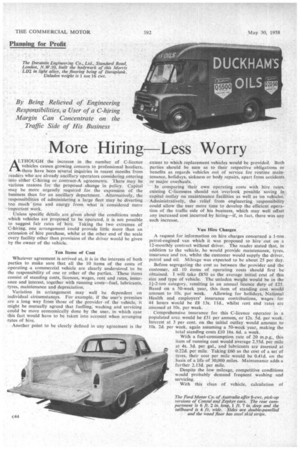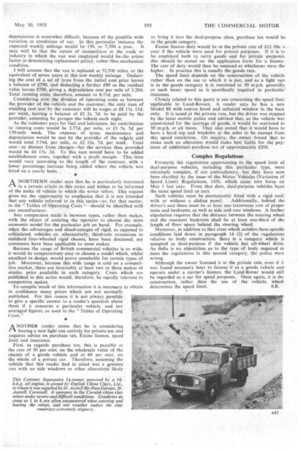More Hiring Less Worry
Page 82

Page 85

If you've noticed an error in this article please click here to report it so we can fix it.
ALTHOUGH the increase in the number of C-licence vehicles causes growing concern to professional hauliers, there have been several inquiries in recent months from readers who are already ancillary operators considering entering into either C-hiring or contract-A agreements. There may be various reasons for the prOposed change in policy. Capital may be more urgently required for the expansion of the business than for an ancillary department. Alternatively, the responsibilities of administering a large fleet may be diverting too much time and energy from what is considered more -important work.
Unless specific details are given about the conditions under which vehicles are proposed to be operated, it is not possible to suggest fair rates of "hire. Taking the two extremes of C-hiring, one arrangement could provide little more than an extension of hire purchase, whilst at the other end of the scale every facility other than provision of the driver would be given by the owner of the vehicle.
Ten Items of Cost
Whatever agreement is arrived at, it is in the interests of both parties to make sure that all the 10 items of the costs of operating a commercial vehicle are clearly understood to be the responsibility of one or other of the parties. These items consist of standing costs, licences, wages, rent and rates, insurance and interest, together with running costs—fuel, lubricants, tyres, maintenance and depreciation.
Variation in arrangement may well be dependent on individual circumstances. For example, if the user's premises are a long way from those of the provider of the vehicle, it might be mutually agreed that fuelling; washing and servicing could be more economically done by the user, in which case this fact would have to be taken into account when arranging -rates of hire.
Another point to be clearly defined in any agreement is the extent to which replacement vehicles would be providea. Both parties should be sure as to their respective obligations or benefits as regards vehicles out of service for routine maintenance, holidays, sickness or body repairs, apart from accidents or major overhauls.
In comparing their own operating costs with hire rates, existing C-licensees should not overlook possible saving in capital outlay on maintenance facilities as well as on vehicles. Administratively, the relief from engineering responsibility could allow the user more time to develop the efficient operation of the traffic side of his business, which may well offset any increased cost incurred by hiring—if, in fact, there was any such increase.
Van Hire Charges A request for information on hire charges concerned a 1-ton.. petrol-engined van which it was proposed to hire out on a 12-monthly contract without driver. The reader stated that, in addition to the vehicle, he would provide maintenance, tyres, insurance and tax, whilst the customer would supply the driver, petrol and oil. Mileage was expected to be about 25 per day.
Before segregating the cost as between the provider and the customer, all 10 items of operating costs should first be obtained. I will take 1850 as the average initial cost of this size and type of vehicle. The unladen weight would be in the 1*-2-ton category,' resulting in an annual licence duty of £25. Based on a 50-week year, this item of standing cost would
amount to 10i. per week. Allowing for holidays, National Health and employers' insurance contributions, wages for 44 hours would be £8 13s. 11d., whilst rent and rates arc assessed at 10s. per week.
Comprehensive insurance for this C-licence operator in a populated area would be 131 per annum, or 12s. 5d. per week. Interest at 3 per cent, on the initial outlay would amount to lOs. 2d, per swek, again assuming a 50-week year, making the total standing costs £10 16s. 6d. a week, With a fuel-consumption rate of 20 m.p.g., this item of running cost would average 2.55d. per mile at 4s. 3d. per gal., and lubricants are assessed at 0.22d. per mile, Taking £60 as the cost of a set of tyres, their cost per mile would be 0.41d. on the basis of a life of 30,000 miles. Maintenance adds a further 2.13d. per mile.
Despite the low mileage, competitive conditions would probably demand frequent washing and servicing.
With this class of vehicle, calculation of depreciation is somewhat difficult, because of the possible wide variation in conditions of use. In this particular instance the expected weekly mileage would be 150, or 7,500 a year. • It may well be that the extent of competition in the trade or industry in which the van was employed would be..,the prime factor in determining replacement policy, rather than mechanical condition.
I will assume that the van is replaced at 52,500 miles. or the equivalent of seven years at this low weekly mileage. Deducting the cost of a set of tyres from the initial cost price leaves a balance of £790, and deducting a further £90 as the residual value leaves £700, giving a depreciation cost per mile of 3.20d. Total i;tinning costs, therefore, amount to 8.51d. per mile;
Considering now the division of operating costs as between the provider of the vehicle and the customer, the only item of standing east met by the customer will be wages at E8 13s, Ild. per week, leaving a balance of -£2. 2s. 7c1. to be paid by the provider, assuming he garages the vehicle each night. As the customer pays for fuel and lubricants, his contribution to running costs would be 2.77d. per mile, or £1 5s. 5d, per 150-mile week. The expense: of tyres, maintenance and depreciation would be met by the-provider of the vekiele and would total 5.74d. per mile, or .£2 12s. 7d, per week. Total cost—as distinct from charges—for the' services thus •provided would be £4 15s. 2d. To this sum would have to• be added establishment costs, together with a profit margin. This item would vary according to the length of the contract, with a lower percentage increase being added where the.' vehicle washired on a yearly basis. .
ANORTHERN reader says that he is particularly interested in a certain article in this series and wishes to be inforMed of the make of vehicle to which -the writer refers. This request gives me the opportunity to emphasize that it is not intended that any vehicle referred to in this series—or, for that matter, in the "Tables of Operating Costs "—should be identified with
any manufacturer. . . .
Any comparison made-is between types, rather than makes, with the object of assisting the operator to choose the most economic model for the particular job on hand. For example, when the. advantages and disadvantages of rigid, as opposed to articulated, vehicles or, alternatively, third-axle extensions to standard four-wheeled rigid chassis, have been discussed, my comments have been applicable to most makes.
Because the range of British commercial vehicles is so wide, it would be comparatively easy to choose a model which, whilst excellent in design, would prove unsuitable for certain types of job. Moreover, because this wide range is sold on a competitive market, there are invariably at least two or three makes of similar price available in each category. Costs which are published in this series would, therefore, be equally relevant to competitive makes.
To compile much of this information it is necessary to obtain in confidence many prices which are not normally published. For this reason it is not always possible to give a specific answer to a reader's question about them if it concerns a particular vehicle, and not averaged figures, as used in the "Tables of Opefating Costs."
ANOTHER reader states that he. is considering buying a new light van entirely for private use and requires advice on purchase tax, Excise licence, speed limit and insurance.
First, as regards purchase tax, this is payable at the rate of 30 per cent, on the wholesale value of the chassis of a goods vehicle and at 60 per cent, on the whole of a private car. Therefore, assuming the vehicle that this reader had in mind was a genuine van with no side windows or other alterations likely to bring it into the dual-purpose class, purchase tax would be in the goods category.
Excise licence duty would be at the private rate of £12 10s. a year if the vehicle were used for private purposes. If it is to be employed both to carry goods and for private purposes, this should. be stated on the application form for a licence The rate of duty would then be assessed at whichever were the higher. In practice this is usually the goods rate,
The speed limitdepends on the constructiort of the vehicle rather than on the use to which it is put, and as a light van is in the 'goods category it is. restricted to 30 m.p.h. generally or such lesser speed as is -specifically required in particular instances, • Closely related to this query is one concerning the speed limit applicable to Land-Rovers.. A reader says he has a new Model 88 with earivas hood and celluloid window in the back Only. It is taxed at the private rate, but the driver was stopped by the local mobile police and advised that, asthe vehicle was constructed for the catriage of goods, it would be restricted to 30 m.p.h. at all times.. They also stated, that it would have to have -a hard top and windows at the sides to be exempt from this 'speed restriction.. On inquiry, the owner-found that to make such an alteration Would make him liable for the payment of additional purchase tax of approximately £200.
. Complex Regulations Formerly the regulations appertaining to the speed limit of deal-purpose vehicles, including this particular type, were extremely complex, if not contradictory,but they have now been clarified by the issue of the Motor Vehicles (Variation of 5peed .Limit) Regulations, 1956, which came into force on May 1 last year. From that ,date, dual-purpose vehicles have the satne speed limit as cars. .
Such vehicles must be permanently fitted with a rigid roof, with or without a sliding panel. Additionally, behind the driver's seat there must be at least one transverse row of proper seats and backrests, as well as side and rear windows. A further stipulation requires that the distance between the steering wheel and the rearmost backrests shall be at least one-third of the length of floor space behind the steering wheel.
Moreover, in addition to that class which satisfies these specific conditions laid down in paragraph 14 (2) of the regulations relative to body construction, there is a category which is accepted as dual-purpose if the vehicle has all-wheel drive. As the is no stipulation as to the type of body required to meet the regulations in this second category, the police were wrong.
Although the owner licensed it at the private rate, even if it was found necessary later to license it as a goods vehicle and operate under a carrier's licence, the Land-Rover would still be regarded as a car for speed purposes. Once again, it is the construction, rather than the use of the vehicle, which determines the speed limit. S.B.




























































































































